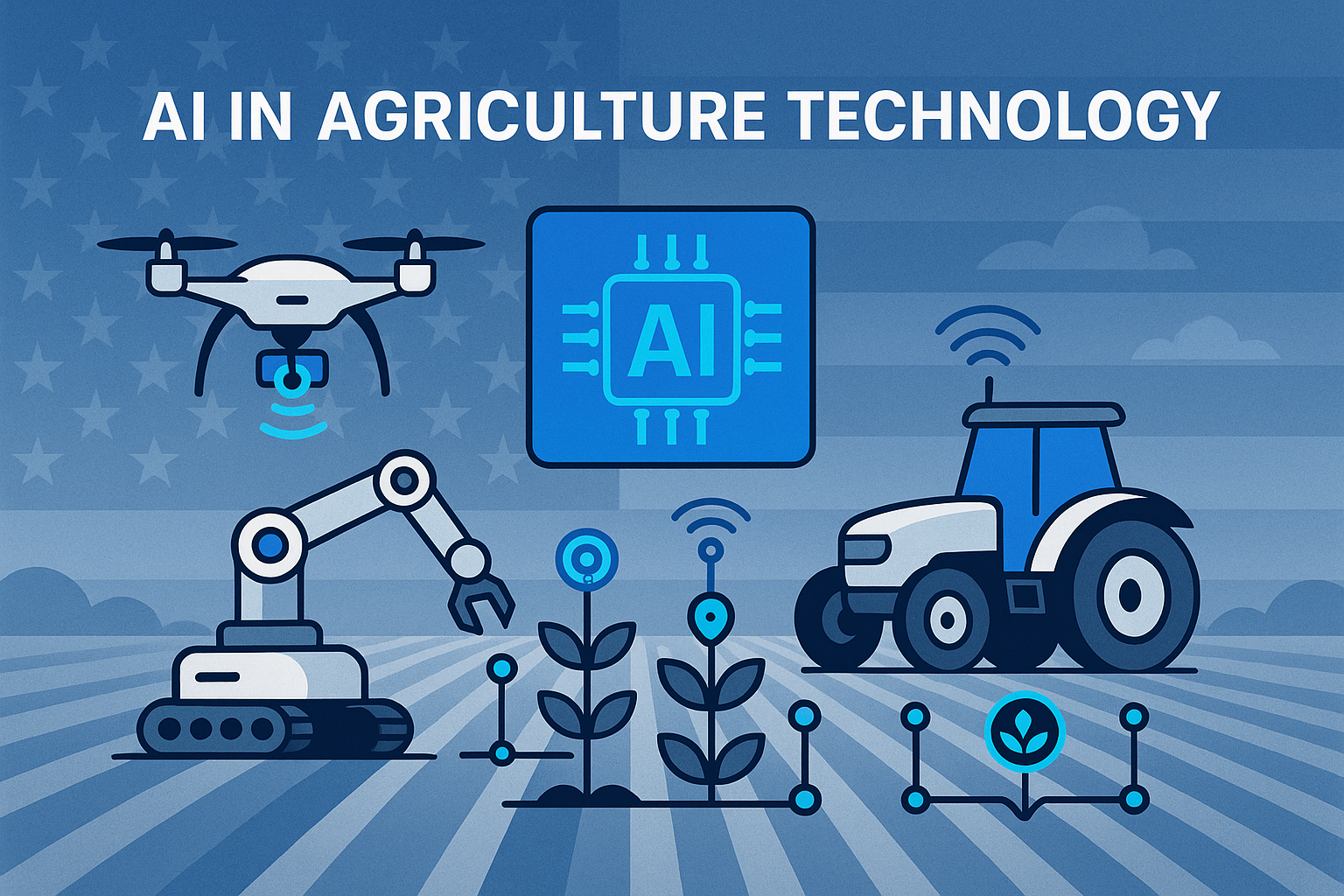
AI in Agriculture Technology: Transforming U.S. Farming in 2025
Artificial Intelligence (AI) is revolutionizing every sector, and agriculture is no exception. In 2025, AI in agriculture technology is driving unprecedented efficiency, sustainability, and profitability for U.S. farmers. From precision farming to predictive analytics, AI-powered solutions are reshaping how crops are grown, harvested, and managed. This comprehensive guide explores the latest trends, top AI tools, and the future of AI in American agriculture.
How AI in Agriculture Technology is Changing U.S. Farming
AI in agriculture technology leverages machine learning, computer vision, robotics, and data analytics to optimize every stage of the farming process. Here’s how AI is making a difference:
- 📈 Yield Optimization: AI algorithms analyze soil, weather, and crop data to recommend optimal planting and harvesting times.
- 🚜 Autonomous Machinery: Self-driving tractors and drones powered by AI reduce labor costs and increase precision.
- 🌱 Disease & Pest Detection: Computer vision identifies crop diseases and pests early, enabling targeted interventions.
- 💧 Smart Irrigation: AI systems monitor soil moisture and weather to automate irrigation, conserving water and maximizing growth.
- 📊 Supply Chain Management: Predictive analytics streamline logistics, reducing waste and improving market timing.
TIP: Integrating AI in agriculture technology can boost yields by up to 30% and reduce resource usage, according to the latest 2025 U.S. agricultural studies.
Top 10 AI Technologies Revolutionizing Agriculture in 2025
The U.S. agriculture sector is adopting a range of AI-powered tools. Here are the top 10 AI technologies making the biggest impact:
- Precision Farming Platforms
- AI-Powered Drones
- Autonomous Tractors
- Crop Disease Detection Systems
- Smart Irrigation Controllers
- Yield Prediction Algorithms
- Automated Harvesting Robots
- Livestock Health Monitoring
- Supply Chain Optimization Tools
- Weed Detection and Removal Robots
Side-by-Side Comparison Table: Top 10 AI Technologies in Agriculture
| Rank | Technology | Main Benefit | Typical Use Case | 2025 U.S. Adoption Rate |
|---|---|---|---|---|
| 1 | Precision Farming Platforms | Maximize yield, reduce waste | Field management | 68% |
| 2 | AI-Powered Drones | Real-time crop monitoring | Aerial imaging | 55% |
| 3 | Autonomous Tractors | Labor savings, efficiency | Plowing, planting | 47% |
| 4 | Crop Disease Detection | Early intervention | Disease/pest scouting | 43% |
| 5 | Smart Irrigation Controllers | Water conservation | Automated irrigation | 39% |
| 6 | Yield Prediction Algorithms | Accurate forecasting | Planning, marketing | 36% |
| 7 | Automated Harvesting Robots | Faster, consistent harvests | Fruit/vegetable picking | 32% |
| 8 | Livestock Health Monitoring | Improved animal welfare | Dairy, beef operations | 28% |
| 9 | Supply Chain Optimization | Reduce spoilage, boost profit | Distribution logistics | 25% |
| 10 | Weed Detection Robots | Reduce herbicide use | Field maintenance | 22% |
Key Benefits of AI in Agriculture Technology for U.S. Farmers
Increased Productivity and Efficiency
✅ AI-driven automation reduces manual labor and increases operational speed, allowing farmers to manage larger areas with fewer resources.
Enhanced Sustainability
🌎 Smart resource management—like AI-powered irrigation—minimizes water and fertilizer usage, supporting eco-friendly farming practices.
Improved Crop Quality and Yield
🌽 Precision agriculture ensures optimal planting, fertilization, and harvesting, resulting in higher-quality produce and increased yields.
Early Problem Detection
🔍 AI-based monitoring identifies diseases, pests, and nutrient deficiencies before they become widespread, reducing crop loss.
Data-Driven Decision Making
📊 Predictive analytics empower farmers to make informed decisions about crop rotation, planting schedules, and market timing.
TIP: U.S. farms using AI in agriculture technology report up to 20% reduction in input costs and 15% higher profits compared to traditional methods.
Challenges and Considerations for AI in Agriculture Technology
While the benefits are significant, there are challenges to consider:
- 💸 High Initial Investment: Advanced AI systems can be costly to implement, especially for small farms.
- 🧑💻 Technical Skills Gap: Farmers may need training to effectively use AI tools.
- 🔒 Data Privacy: Managing sensitive farm data securely is crucial.
- 🌐 Connectivity Issues: Rural areas may lack the high-speed internet needed for real-time AI applications.
TIP: Government grants and cooperative extension programs are available in 2025 to help U.S. farmers adopt AI in agriculture technology.
The Future of AI in Agriculture Technology: Trends for 2025 and Beyond
AI in agriculture technology is poised for rapid growth in the coming years. Key trends include:
- Integration with IoT: AI will increasingly work alongside sensors and connected devices for real-time farm monitoring.
- Edge Computing: On-site AI processing will reduce reliance on cloud connectivity, making solutions more accessible in rural areas.
- Personalized Farming: AI will deliver tailored recommendations for individual fields and crops, maximizing efficiency.
- Sustainable Practices: AI will drive regenerative agriculture, carbon tracking, and climate-smart farming.
Conclusion: Embracing AI in Agriculture Technology for a Sustainable U.S. Future
AI in agriculture technology is transforming the American farming landscape in 2025. By harnessing the power of machine learning, robotics, and data analytics, U.S. farmers are achieving higher yields, greater efficiency, and more sustainable operations. While challenges like cost and technical skills remain, the benefits—ranging from increased productivity to environmental stewardship—are undeniable. As AI continues to evolve, its integration with IoT, edge computing, and personalized farming will further revolutionize agriculture. For U.S. farmers looking to stay competitive and sustainable, embracing AI in agriculture technology is not just an option—it’s the future.